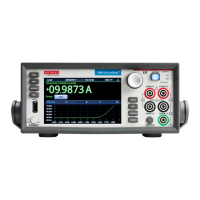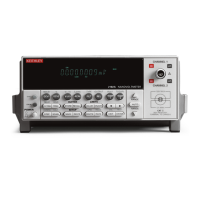2: General operation Model 2461 Interactive SourceMeter® Instrument
2-56 2461-901-01 A/November 2015
Supported remote interfaces
The Model 2461 supports the following remote interfaces:
• GPIB: IEEE-488 instrumentation general purpose interface bus
• USB: Type B USB port
• Ethernet: Local area network ethernet communications
• TSP-Link: A high-speed trigger synchronization and communications bus that test system
builders can use to connect multiple instruments in a master-and-subordinate configuration
For details about TSP-Link, see TSP-Link System Expansion Interface (on page 3-150).
Comparison of the communications interfaces
The following topics discuss some of the advantages and disadvantages of the communications
interfaces that are available for the Model 2461.
Simplicity
The GPIB interface is the simplest configuration. Connections are simple, and the only necessary
software configuration is setting the instrument address.
An ethernet network is a simple configuration if you can use the automatic settings. It is more
complicated if you need to set it up manually. If you must set up your ethernet network manually, you
need some knowledge of networking. In addition, your corporate information technology (IT)
department may have restrictions that prevent using an ethernet network.
A USB interface is also simple to set up. However, it requires an instrument-specific device driver to
communicate with the instrument. This can limit the operating systems that are available for use with
the instrument.
Triggering
The GPIB interface provides the fastest, most consistent triggering. It has the lowest trigger latency of
the available communications types. Trigger latency is the time that it takes the trigger to go from the
computer to the instrument. GPIB also allows you to send triggers to multiple instruments
simultaneously.
If you use a USB interface, it is difficult to synchronize triggers that are sent to multiple instruments.
For applications that require synchronized triggering, you must use digital I/O. The trigger latency with
a USB interface is higher than latency with a GPIB interface, but it is lower and more consistent than
latency with an ethernet interface.
Transfer rate
Of the available interfaces, USB has the fastest transfer rate, followed by the ethernet and GPIB
interfaces. The GPIB interface, however, offers the most consistent transfer rate.
Instrument naming
Names for instruments that are named through NI-VISA
TM
are in a human-readable format. USB
instrument names are not intended to be human-readable.

